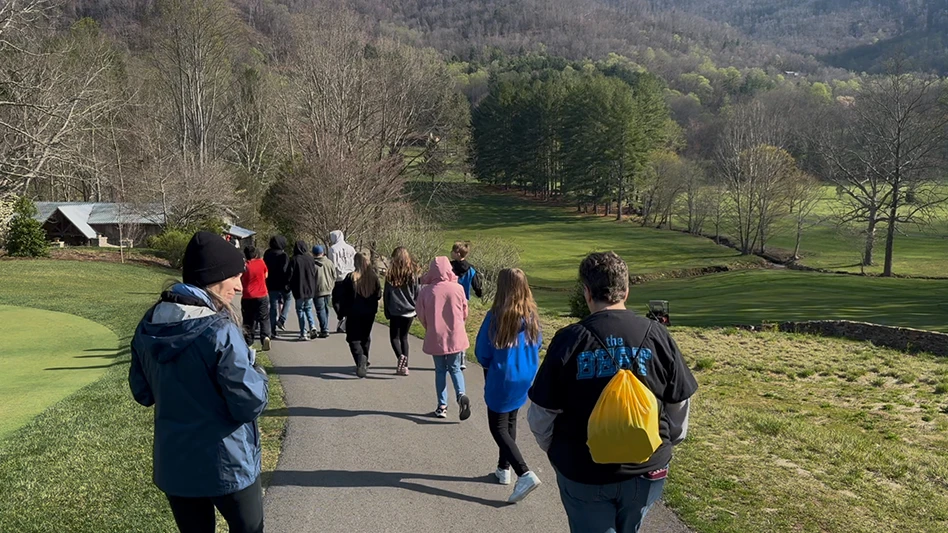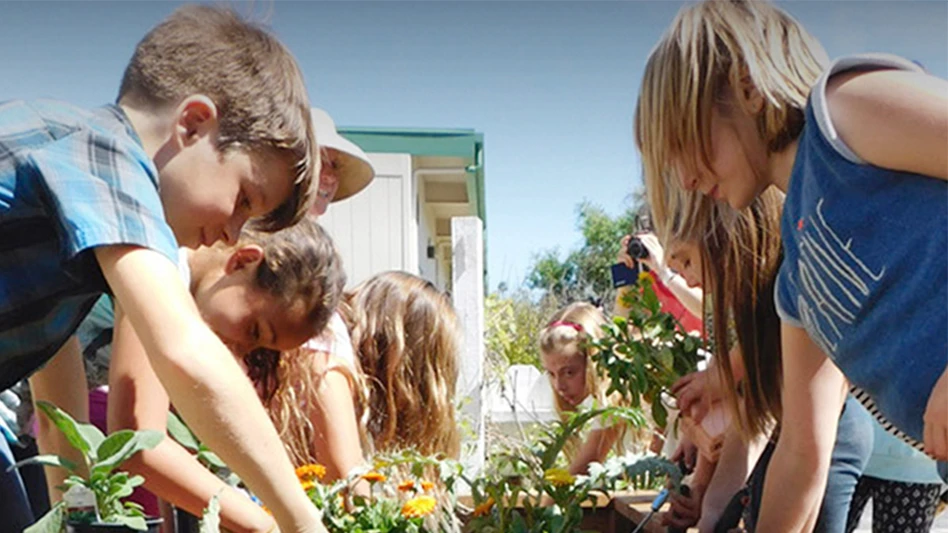
Pottawatomie Golf Course is both a time capsule and a time machine.
Packed into 42 acres along the Fox River in St. Charles, Illinois, an hour and change west of downtown Chicago depending on traffic, the course is one of 254 either constructed or renovated by the Works Progress Administration — whose most famous golf projects were almost certainly the Black, Blue, Green and Red courses at Bethpage State Park — and still shines a light on what the United States can do, together, when pushed hard against a societal wall. Walk around enough WPA projects and you almost feel the labor and the longing to escape the Great Depression, some eight decades later.
Pottawatomie also features just nine holes — a positive when the course opened in July 1939 and rounds were as inexpensive as 15 cents, and a positive today when the very idea of the game is shifting, when time is our most valuable resource, and full mornings or afternoons hoofing around 18 holes are fewer and ever more far between. Almost by accident, Robert Trent Jones Sr. laid out a golf course for our modern times when he sketched these nine — and what is recognized as his first island green — during the late 1930s.
“What’s the point in making the course so difficult that people don’t enjoy it?” superintendent Denise Gillett-Parchert asks rhetorically. “You can play a quick nine and even if the course is packed, you can still get around in 2 hours, 15 minutes, and you go about your day.”
Like the course she has tended to the last 23 years, Gillett-Parchert is herself both a time capsule and a time machine. After studying floral design at Joliet Junior College — and determining “after one class that it wasn’t for me” — she shifted toward golf course maintenance and landed a summer internship at Cog Hill Golf & Country Club in 1980. She was often the lone woman on the crew, and she was often cast aside. During nearly two decades working on private courses, she was subject to the casual misogyny of that time and was turned down for at least one superintendent job despite being told by the person in charge of hiring that she was the most qualified applicant. “Being a female at that time with aspirations of getting a gig at an 18-hole private golf course was very difficult,” she says.
After her husband landed a position that tied them to the area, she applied to and was hired by Pottawatomie in 1999 near the height of the Tiger Boom. Projects were plenty, even if women working courses weren’t.
“The second or third year I was superintendent here, the GCSAA at one of their conventions had a Women in Golf panel and I was invited,” she says, remembering the exact number of women who held positions of some authority at that time: 184. “I think the industry has come a long way. The kind of prejudice that I experienced at first would never be tolerated today. But it made me who I am, so there’s no angst or anything like that. It’s just the way it was.”
For more than four decades, Gillett-Parchert has put her head down and worked. For more than eight decades, Pottawatomie has done the same.
Owned and operated by the St. Charles Park District, Pottawatomie trumpets its past — the Jones design, the WPA funding, the original green fees and land value ($50,000 in May 1936, which works out to a little more than $1 million, though surely 42 acres of riverfront property today would sell for far more) — but also promotes its present and future far more often: Leagues, tournaments, lessons with golf course manager and professional Ron Skubisz, who has worked at Pottawatomie for more than a decade. The course handled more than 36,000 rounds last year.
“We really, really encourage all ages and all degrees of players,” Gillett-Parchert says. “If you’ve never had a club in your hand, you are more than welcome here. If you’re a scratch golfer, you’re equally welcome. We just want to provide a place where anybody and everybody can come and play — and feel comfortable.
“You get into the higher end of public golf courses, or private golf courses, you only have certain days that women can play, or kids can play. We think it’s important to promote the game of golf, and that’s what we’re here for.”
Gillett-Parchert reports to Skubisz — an unusual situation, she says, but one that works. “Ron’s attitude is that I know more about the nuts and bolts of the golf course than he could possibly know,” she says. “So, if I say I need to do this or I need to do that, I generally have his full backing.” Generally? “When I say carts should go, he kind of gives me the hairy eyeball. His job is to generate revenue.” She laughs. “But he totally supports what I do and how I do it.”
She works alongside a single other full-time employee — assistant superintendent Edgar Portillo, who worked 20 years at nearby Pheasant Run Golf Course, part of a larger resort and convention center, all of which closed in 2020 — and a handful of retirees and students who work 20 to 25 hours. One retiree just mows fairways. Another just mows tees, approaches and banks.
“I’m lucky that we’re small enough that we get it done,” she says. “Sometimes it takes us a little longer, but when the kids come in from school, we’re able to get a few extra things done. We do most everything in house unless it’s something huge we can’t take down ourselves.”
Every year seems to bring a different project: Shoreline stabilization. Irrigation. Reshaped tees. Renovated bunkers. More drainage. New cart paths. New bridges. “Who wants to stand still?” Gillett-Parchert asks with a laugh. “Well, I shouldn’t say that. I do, kind of, now. You know, 23 years later, I wouldn’t mind. But now the golfers expect something to be changed. It’s OK. It’s fun.”
Her son, J.C., was 7 when she started working at Pottawatomie. He played 18 or 27 holes every summer day for years, then joined three other Parks District staffers’ kids and formed the SAS — the Seed and Soil Crew — filling divots on par-3s to earn rounds before joining his mom’s crew during high school and college. He’s 30 now. He and his wife are expecting their first child this summer. Gillett-Parchert is over the moon and already planning weekend trips. Now 61, her remaining years as a superintendent will most likely be outnumbered by her years as a grandmother.
Not long before Gillett-Parchert arrived at Pottawatomie, Luke Cella, then the course superintendent and now the executive director of the Midwest Association of Golf Course Superintendents, helped the course become the first 9-holer to be fully certified by the Audubon Cooperative Sanctuary.
“We really are stewards of this property for a very short time,” she says. “Someday, I’m going to leave here and I want to make sure that I leave it in a way that someone else can manage it and it will be here in 50 years for somebody else’s grandchildren to play.”
Gillett-Parchert looks toward the future as easily as she recounts the past, remembering some of the many golfers who have played on her work.
“One golfer, Chris May, used to call this place Cheers Without the Beers,” she says. “When Ron came, he started selling beer, so it was just Cheers: Everybody knows your name, that’s sort of the attitude around here that we take. Because we are so familiar with so many of the golfers, they say, ‘What’s new, Denise?’”
May played the course growing up in St. Charles and became a Saturday-Sunday regular, his tee time written in ink. “This was his happy place,” Gillett-Parchert says.
May died a few years ago. Every time Pottawatomie feels like the domain of Sam, Diane, Coach, Carla, or Norm is a nod to May. “We have a lot of regulars, guys and women who have their tee time and it’s just their happy place.”
For them, perhaps Pottawatomie is neither a time capsule nor a time machine, but a carousel: allowing them to travel around and around, nine holes at a time, to a place they know they are loved.
“When I got this job, I was able to be a mom and a superintendent,” Gillett-Parchert says. “I got here, I stayed here and I loved it. I made some changes on the golf course and now it’s a pretty nice 9-holer— so they tell me.
“You’re only as good as the people walking off the ninth hole.”

Explore the May 2022 Issue
Check out more from this issue and find your next story to read.
Latest from Golf Course Industry
- From the publisher’s pen: Watery dilemma
- The Aquatrols Company hires marketing manager
- Renovating Bredemus in West Texas
- Renovation starts at Okatie Creek GC at Sun City Hilton Head
- The Fittest Podcast in Turf: Episode 1
- New 6-hole course debuts in Oklahoma
- GCSAA announces Grassroots Ambassador Leadership Award recipients
- Reel Turf Techs: David Gummo







